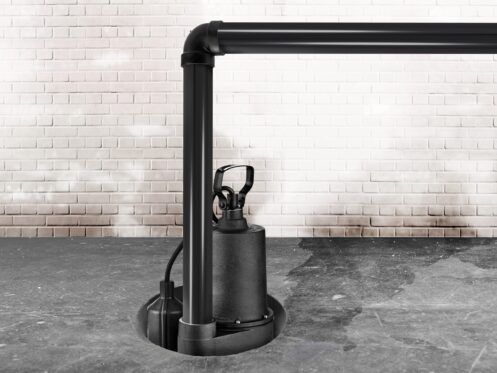A working sump pump in your home can provide you with great peace of mind. Heavy rains always have the potential to cause your home’s basement or crawlspace to flood. This isn’t something you need to worry about with a sump pump as the unit will continuously pump water out from the soil underneath and around your foundation and direct it away from the home to prevent possible flooding.
The rainy season in South Jersey typically lasts from the end of March until the end of August or early September. Major rainstorms and deluges are possible at any time during these months, and this makes it important that you take a few simple steps to ensure your sump pump is ready to go and working properly before the summer rains start. Today, we’re going to provide a full overview of how to ensure your sump pump is ready for summer and also other maintenance tips that can help improve performance and prevent your pump from breaking down.
Testing the Functionality of a Sump Pump
The best and only effective way to ensure your sump pump is functioning properly is to fill up your sump basin with water and then monitor the pump’s performance. Depending on the type of unit you have, you may also be able to run a dry test by triggering the pump to run without adding water to the sump basin.
If the unit has a float switch, all you need to do is raise the switch a few inches until the pump kicks on. However, you want to make sure that you then set the switch back down immediately so that the pump shuts off. The reason is that running a pump dry can quickly cause the motor to overheat and potentially burn out. Dry testing a pump will at least let you know that the unit still turns on, but it isn’t an effective option as you also want to make sure that the unit can pump effectively.
For these reasons, we would always recommend testing a sump pump with water if at all possible. The easiest way to do this is to run a hose from outdoors into your basement or crawlspace. If you have a nozzle on the end of the hose, this is something you can do on your own. If not, you will need another person outside to turn the water on and off. If running a hose isn’t an option, you can also fill up a couple of five-gallon buckets with water and dump them in the basin.
You typically only need to fill up the basin with a few inches of water to trigger the switch so the pump starts running. Nonetheless, you are always best to add at least 10 gallons of water so that the pump runs for slightly longer and you can better monitor its performance. Loud or unusual noises when the pump is running is usually a sign that you need to have the unit repaired or replaced.
Timing how long it takes for the pump to empty the basin is also important for ensuring it is pumping as effectively as it should. Most sump pumps are rated to pump anywhere between 20 and 80 gallons of water per minute, and you should be able to find your pump’s rating listed somewhere on the unit. If your pump is rated at around 20 gallons per minute, it should only run for around 30 seconds after you dump 10 gallons of water in the basin. If the pump runs for a minute or more, you may want to think about having it replaced. In this situation, the pump may be too old or have some other issue that is preventing it from pumping as effectively. If the pump isn’t working effectively, the basin may overflow during a major rainstorm and lead to your basement or crawlspace still being flooded.
After performing the initial test, it is also a good idea to fill up the basin at least halfway. Once the pump starts running, you should then monitor the discharge pipe outside of your home to make sure the water is flowing out of the pipe. If you don’t see any water flowing or only a little water trickles out, the discharge pipe could be clogged or broken. Discharge pipe issues can render a sump pump almost useless as it can lead to the water leaking out near your foundation and seeping directly back inside. In this case, your sump pump may run almost constantly without having any major effect.
Cleaning the Sump Basin
It is also a good idea to check your sump basin before summer starts and remove any debris that may have gotten inside. Any debris in the basin could clog the inlet on the pump, which can prevent the pump from working as effectively or lead to it not pumping any water at all. This creates a potential for flooding and can also ruin the pump altogether. If no water flows through the unit, the motor can quickly start overheating and may end up burning out.
Inspecting and Cleaning Your Sump Pump
It is also a good idea to fully remove your sump pump from the basin so you can inspect and clean the unit before summer starts. This is something you can do on your own, but you may not want to as the pump itself and the basin can be quite nasty since a small amount of water is often always present at the bottom of the basin.
If you do want to do this on your own, you will want to inspect the unit for any visible signs of damage. You should also clean off any rust and gunk from the unit as this can help prevent corrosion and extend the life of your pump.
The most important thing to do here is to thoroughly clean the pump’s intake screen. The screen works to prevent the pump from sucking in any rocks and other debris, which is important as this will usually ruin the unit. Whenever the unit runs, some dirt and debris can get stuck in the screen and will eventually start to clog it. If the screen is fully or even partially clogged, the pump won’t work effectively and the motor could burn out.
On submersible pumps, the intake screen is located on the base of the unit. If you have a pedestal pump, the screen is located at the end of the pipe that extends into the sump basin. The easiest way to clean the screen is by using warm, soapy water and a toothbrush or other bristled brush to thoroughly scour away any dirt and debris.
At Laury Heating Cooling & Plumbing, our team is here to help ensure your sump pump is ready for summer storms. We can also help if you need a new pump installed. We specialize in all other types of residential plumbing services as well as heating and air conditioning repair, maintenance, and installation. Give us a call today if you have any questions or need to schedule a service call in the Vineland or Pennsville areas.



